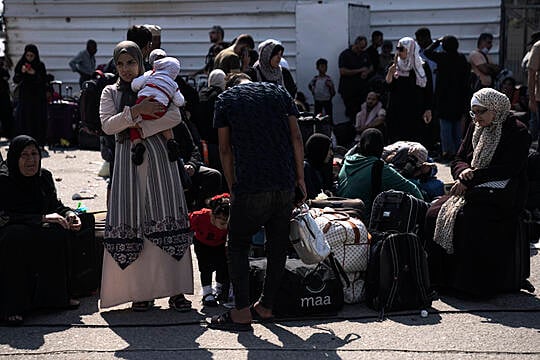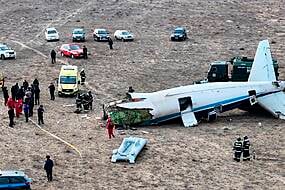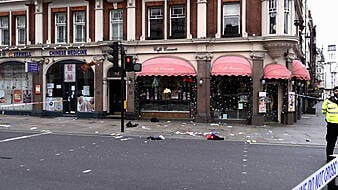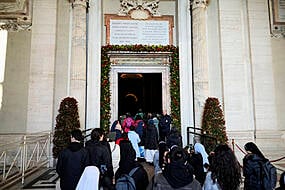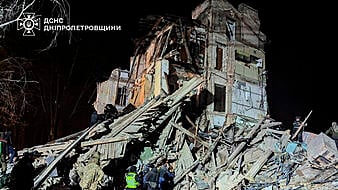Truckloads of aid remain stalled at Egypt’s border with the Gaza Strip as residents and humanitarian groups plead for water, food and fuel for dying generators, warning that the tiny Palestinian territory sealed off by Israel after a rampage by Hamas is near total collapse.
Hospitals full of wounded were on the verge of losing electricity, and hundreds of thousands of Palestinians displaced from their homes are searched for food.
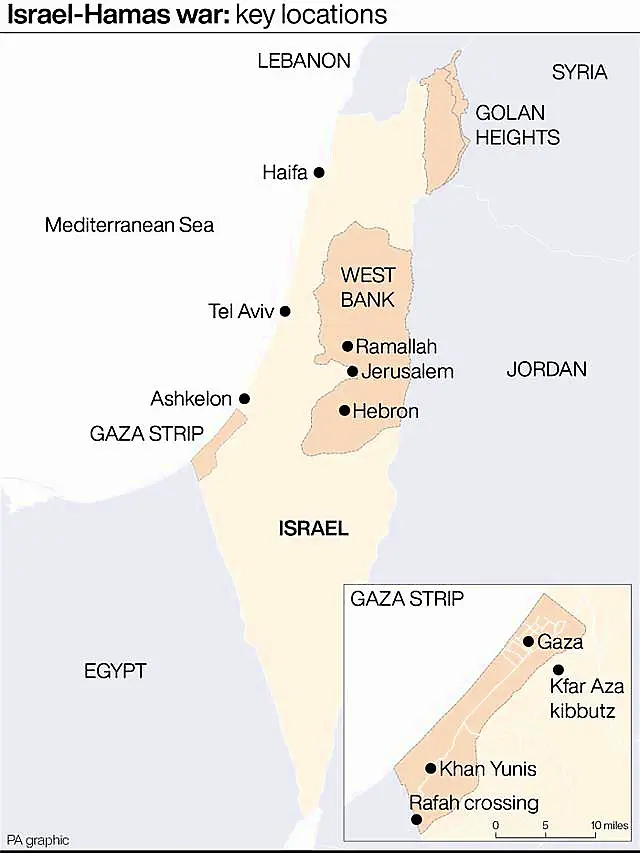
Israel maintained punishing air strikes across the territory as a ground invasion loomed, while Hamas militants kept up a barrage of rocket attacks and tensions mounted near the Israel-Lebanon border.
More than a week after Israel stopped entry of any supplies, all eyes were on the Rafah crossing, the Gaza Strip’s only connection to Egypt, as mediators try to reach a ceasefire deal that would allow aid in and trapped foreigners out.
Israeli air strikes forced the crossing to shut down last week, and local media reported that it was struck again on Monday.
Israel evacuated towns near its northern border with Lebanon, where the military has exchanged fire repeatedly with the Iranian-backed Hezbollah group, as US secretary of state Antony Blinken met Israel’s defence minister, and President Joe Biden weighed whether to visit Israel after an invitation from Prime Minister Benjamin Netanyahu.
Speaking to the Israeli Knesset on Monday, Mr Netanyahu warned Iran and Hezbollah: “Don’t test us in the north. Don’t make the mistake of the past. Today, the price you will pay will be far heavier,” referring to Israel’s 2006 war with Hezbollah, which operates out of Lebanon.
Soon after he spoke, the Knesset floor was evacuated as a rockets headed towards Jerusalem, part of a steady stream of attacks militants have launched from Gaza into Israel. Sirens in Tel Aviv warning of incoming rockets prompted staff to duck into stairways for cover as visiting US secretary of state Antony Blinken met Israel’s defence minister.
This has become the deadliest of the five Gaza wars for both sides. At least 2,778 have been killed and 9,700 wounded in the Gaza Strip, according to the Heath Ministry there, and more than 1,400 Israelis have been killed, the vast majority civilians in Hamas’s October 7 assault.
The Israeli military said on Monday that at least 199 hostages had been taken back to Gaza, higher than previous estimates. The military did not specify whether that number includes foreigners.
Hamas said later that it was holding 200 to 250 hostages, including foreigners who it said it would free when it was feasible.
The head of Israel’s Shin Bet security service, in charge of monitoring militant groups, took responsibility for failing to avert Hamas’s surprise attack.
As agency head, “the responsibility for that is on me”, Ronen Bar said. “There will be time for investigation — now is a time for war,” he wrote in a letter to Shin Bet workers and their families.
The combination of air strikes that pulverise entire neighbourhoods, depleting supplies, and Israel’s mass evacuation order for the north of the Gaza Strip threw the tiny territory’s 2.3 million people into upheaval.
More than a million have fled their homes, and 60% of them are in the approximately eight-mile area south of the evacuation zone, according to the UN.

The Israeli military says it is trying to clear away civilians for their safety ahead of a major campaign against Hamas in the northern Gaza Strip, where it says the militants have extensive networks of tunnels and rocket launchers. Much of Hamas’s military infrastructure is in residential areas.
Those fleeing northern Gaza still face the threat of air strikes in the south. Before dawn on Monday, a strike hit a building in the town of Rafah where three displaced families who fled Gaza City were sheltering. At least 12 people were killed and nine others remained missing, said survivors from the al-Masry, al-Akhras and Hamouda families.
More than 400,000 displaced people in the south were crowded in schools and other facilities of the UN agency for Palestinians, UNRWA, but the group cannot provide them aid, leaving them to search for water and food. UNRWA said it has only a litre of water a day for each of its staff trapped in the territory.
Gaza is running dry.
People across📍#Gaza have severely limited access to clean drinking water.
A quarter of a million people moved to shelters over the past 24 hours - the majority of which are in @UNRWA schools where “clean water has actually run out” pic.twitter.com/WhEa988sDN— UNRWA (@UNRWA) October 16, 2023
Hundreds of thousands more displaced people have moved in with family members, packing dozens into homes.
With taps dry, many have resorted to drinking dirty or sewage-filled water, risking the spread of disease.
“Gaza is running out of water, and Gaza is running out of life,” said UNRWA chief Philippe Lazzarini, calling for an immediate lifting of the siege.
For a third day, Israel’s military announced a safe corridor for people to move from north to south between the hours of 8am and noon. It said more than 600,000 people have already left the Gaza City area.
In northern Gaza, unknown numbers remain, either unwilling or unable to leave.

UNRWA said 170,000 people were sheltering at its schools in the north when the order to leave came, but it could not evacuate them and does not know if they remained. More than 40,000 have crowded in the grounds of Gaza City’s al-Shifa Hospital and surrounding streets, hoping it will be safe from bombardment.
UNRWA said on Monday it received reports that the Hamas-run Ministry of Health removed fuel and medical equipment from its evacuated compound in Gaza City.
Hamas urged people to ignore the evacuation order, and the Israeli military on Sunday released photos it said showed a Hamas roadblock preventing traffic from moving south.
Hospitals in the Gaza Strip are expected to run out of generator fuel in the next 24 hours, the UN said.

Four hospitals in northern Gaza are no longer functioning and 21 have received Israeli orders to evacuate. Doctors have refused, saying it would mean death for critically ill patients and babies on ventilators.
The medical aid group Doctors With Borders said many of its personnel decided to stay in the north to treat wounded. They had run out of painkillers, and staff reported “wounded screaming in pain”, it said.
Israel has said the siege will not be lifted until Hamas releases all the captives, but the country’s water ministry said supplies had been restored at one “specific point”, outside the southern town of Khan Younis. Aid workers in Gaza said they had not yet seen evidence the water was back.
The World Health Organisation said assistance for 300,000 patients was awaiting entry through Rafah. On the Gaza side of the crossing, crowds of Palestinians with dual citizenship waited anxiously, sitting on suitcases or crouched on the floor, some comforting crying children.
